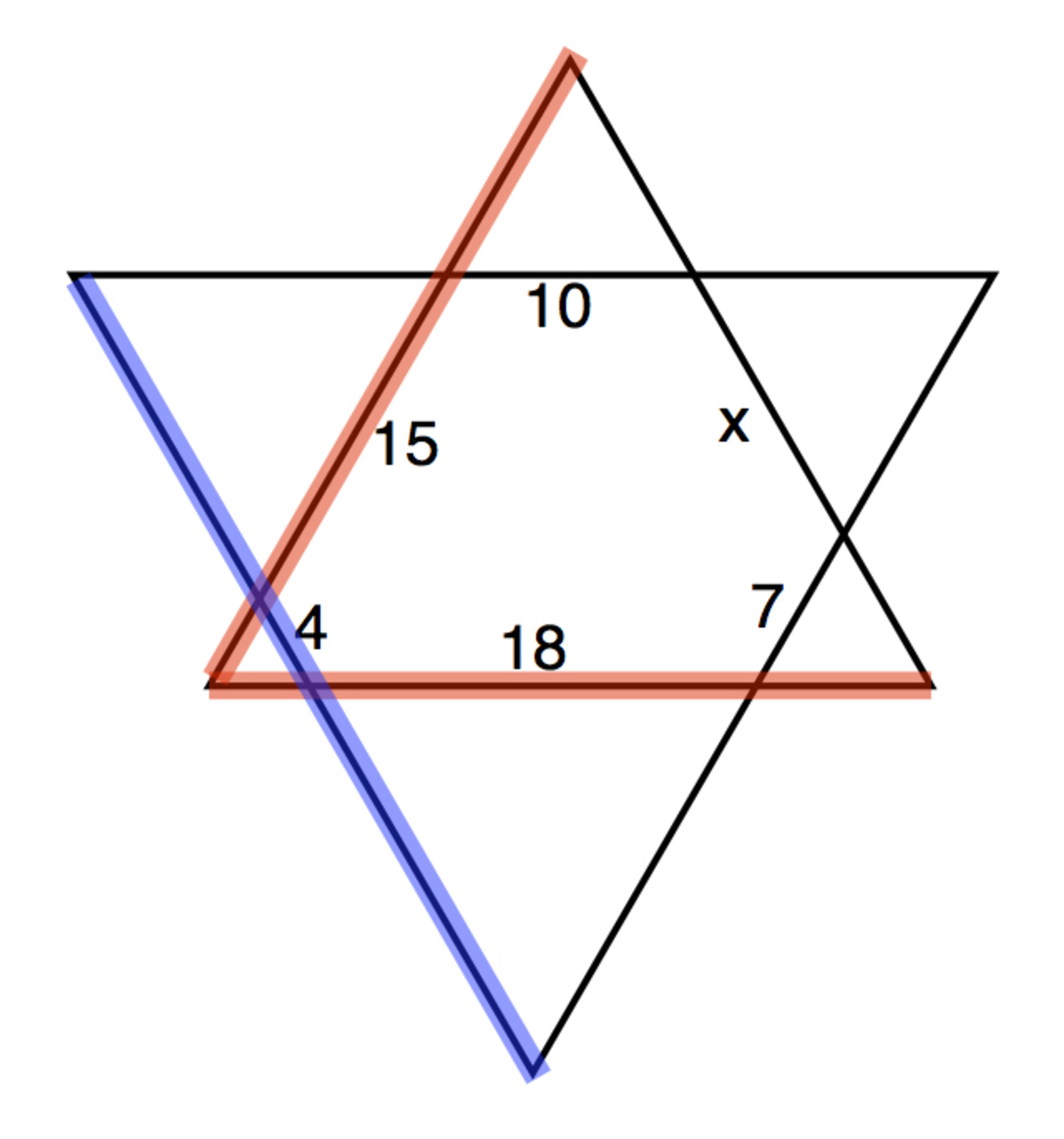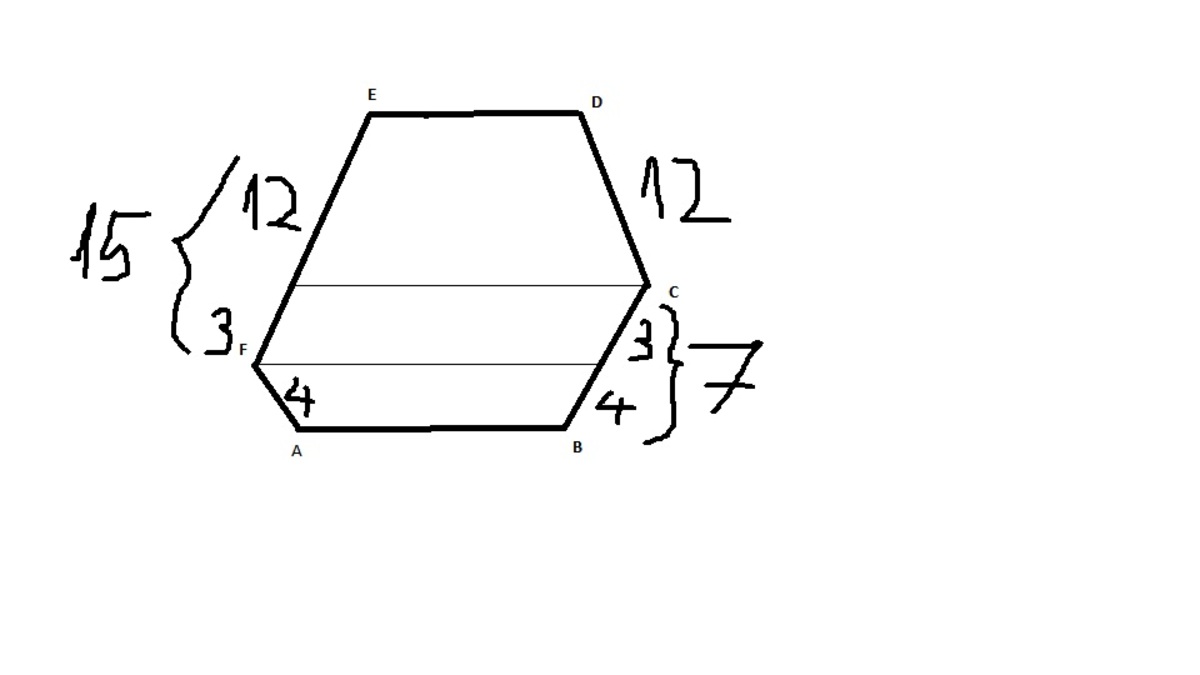An interesting hexagon
The hexagon below has interior angles that measure all the same. As shown, only five of the six side lengths are known: 10, 15, 4, 18, 7. What is the unknown side length?
This section requires Javascript.
You are seeing this because something didn't load right. We suggest you, (a) try
refreshing the page, (b) enabling javascript if it is disabled on your browser and,
finally, (c)
loading the
non-javascript version of this page
. We're sorry about the hassle.
20 solutions
As is obvious from the given picture,
Δ
P
Q
R
is equilateral. We can calculate the length of the required side without knowing one of the other sides, or to say we can derive the length of any two sides given the measure of the rest four sides( in the given configuration) /only.
A necessary and sufficient condition for such an equiangular hexagon is the absolute difference of the length of pairs of opposite sides (that's a mouthful to say) is constant. IE ∣ 1 8 − 1 0 ∣ = ∣ 1 5 − 7 ∣ = ∣ 4 − ? ∣
@Áron Bán-Szabó You can remove the length of any one side of the hexagon. I guess you used cosine rule (if u have framed it). So, extra information here. :)
elegant :)
Really clever. Bravo.
Great solution.
You don't have to say "as is obvious from the picture". We're told the hexagon is equiangular. Thus all of its interior angles are 120 degrees. That's the fact that lets you add small equilateral triangles in the manner implied by the picture to create a larger equilateral triangle.
Log in to reply
@Richard Desper I agree. Nice solution, even easier than what I did (project all lengths onto line through C D , the slanted lines will then halve in length).
One simple solution is to note that since all interior angles are equal, namely 1 2 0 ∘ , then:
F A + F E = B C + C D (since the absolute value of their slopes is equal if you take A B to be flat)
or
4 + 1 5 = 7 + ?
? = 1 2
That's how I did it. I doubled checked because the questioner has also given us lengths AB and ED, which aren't necessary (but perhaps were put in to throw us off the solution!).
Given those extra lengths, another solution would be:-
FA + AB = ED + DC
or
4 + 18 = 10 + ?
This is clearly an example of a dead reckoning problem from a given staring point (0,0) and traveling along various legs of given length (the given sides of the hexagon) and direction (from the given 120 degrees of the original hexagon) and predicting where one ends up in relation to the starting point. Such an approach was used by Charles Lindbergh in 1927 when he flew across the Atlantic as well as (unfortunately), Amelia Earhart, when she attempted to cross the vast Pacific in 1937.
Direction sin cos path (length)
180 0.000 -1.000 10
240 -0.866 -0.500 15
300 -0.866 0.500 4
0 0.000 1.000 18
60 0.866 0.500 7
delta Y delta X
0.000 -10
-12.990 -7.5
-3.464 2
0.000 18
6.062 3.5
Initial Starting Point 0.000 0.000
Final Resting Point -10.392 sum delta Y 6.000 sum delta X
? = 12 [sqrt(6.000^2 + -10.393^2)]
Treat the hexagon [first five sides (paths)] as a “dead reckoning” course: initial course starting at 0, 0 = 10 units @180° second leg 15 units @240° third leg 4 units @300° fourth leg 18 units @0° fifth leg 7 units @60° You wind up at (6, -10.392); from there to starting point (of 0,0) = sqrt(6^2 + -10.3922^2) = 12 (the final answer)
The “beauty” of this approach is, although tedious, that this always yields the correct answer, no matter how many legs of the path provided (whatever the polygon is), the length of each leg is known and the direction is known. No insight into constructing geometric equilateral triangles is required and works even if there are no equilateral triangles constructible.
Log in to reply
Your comment is more interesting than the solution!!!!
Doesn't your solution only show that the answer is close to 12? How do you know that the answer is exactly 12?
Extend the sides measuring 10 and 18, and draw a rectangle such that the hexagon is inscribed in the rectangle. Being that each angle of a regular hexagon measures 120°, we now have four 30-60-90 triangles, as shown below.
Using the ratios for 30-60-90 triangles, we find the measures of the sides of these triangles, as demonstrated. AD is found by 15/2 √3+2√3 = 19/2 √3. BC = AD, so we find the missing segment of BC by 19/2 √3 - 7/2 √3 =6√3. Again using the ratios for 30-60-90 triangles, we find x = 12.
Like you, I drew a rectangle around the hexagon. Note, however, that you do not need to calculate its height – 2 measures (1 partial) of the length (top and bottom) are sufficient (which involves only divide-by-twos, adding then subtracting top from bottom). Thus X/2 = (18+4/2+7/2)-(15/2+10) = 6 => X=12.
All interior angles are 1 2 0 ∘ , so horizontal lines through the left and right extreme points make 6 0 ∘ angles with the adjacent sides. Total horizontal travel from the extreme right point, moving clockwise around the figure, is therefore − 7 / 2 − 1 8 − 4 / 2 + 1 5 / 2 + 1 0 + x / 2 = 0 , so x = 1 2
Beautiful!
This is the best solution..
The interior angles of an equiangular hexagon are each 120˚. This makes their exterior angles 60˚. If each side of the equiangular hexagon is used to make an equilateral triangle, the overall resulting shape is two large overlapping equilateral triangles (see figure below). In that figure, the highlighted sides of the two large equilateral triangles are completely determined and may be used to determine the unknown side length, x.
The congruent sides of the "downward" equilateral triangle are: (18 + 15 + 4) = (18 + 7 + x) = ( 15 + 10 + x).
The congruent sides of the "upward" equilateral triangle are:
[15 + 10 + 4] = [18 + 7 + 4] = [10 + 7 + x].
 (37) = (25 + x) is consistent with [29] = [17 + x] with the result that
x = 12
.
(37) = (25 + x) is consistent with [29] = [17 + x] with the result that
x = 12
.
ps. with a little imagination, it is possible to solve this problem with parallelograms. Try it!
A very simple solution is the following, since all angles are equal then the sum of its sides should be a multiple of 6. To the sum of the known sides only the addition of 12 (amongst the given figures) gives a multiple of 6. Indeed, 10+15+4+18+7+...12= 66.
Why should it be a multiple of 6?
Let the Unknown length is "x" Then using cosine rule 19^2 +22^2 - (2)(19)(22)cos60 = (10+x)^2 +(7+x)^2 - 2(10+x)(7+x)cos60. When this equation is simplified we get the quadratic equation x^2+17x-348=0. When this equation is solved we get x=12 or x=-29 So the acceptable answer is 12.
As In a hexagon length of opposite sides are equal i.e 15+4=x+7 19=x+7 X=19-7 X=12
Extend the sides marked 18, 15 and ? to get an equilateral triangle. Take a look at it and do the arithmetic :-)
I made a little GeoGebra applet to introduce this to people. https://www.geogebra.org/m/t93hTH3s
Love the problem, Áron!
... very neat GeoGebra applet! Thx.
Each side of the hexagone is drawn as a vector. The sum of all vectors must be zero. The unknown vector has a magnitud of 12
Sorry, I don't see the connection to vectors. Care to elaborate on this?
For this problem I just realized that to travel in a closed loop, the vector sum of all paths must be zero.
You can use symmetry to remove most of the work, take the difference between each pair of sides -- and realize they must be equal.
The known pairs come to 8, so the remaining difference must also be 8. Ergo - the length must be 12.
But how do you know such a configuration exists? If I replace one of the sides by the length of 10^1000000, does that mean that the hexagon still exists?
Log in to reply
If you can replace one of the sides with 10^1000000 while keeping the problem's condition of "having a hexagon", I ask you to go right ahead!
We really do not need the side 18 and that can be determined. To do so extend right, left, and bottom sides in both directions till you see you have an equilateral triangle, let the unknown side x and 18, y, then: 10 + 15 + 4 = 4 + y + 7 = 7 + x + 10, so y = 18, x = 12.
Interior Angles are found by (n-2) 180/n which yields 120 degree interior angles. You can then form right triangles on the left hand side using 30-60-90 degree triangles. The height of the 2 triangles will sum to 9.5 sq.rt. of 3. The triangle on the bottom right hand side has a height of 3.5 sq.rt. of 3 which means that the triangle on the top right hand side must have a height of 6 sq.rt. of 3. The length of the hypotenuse of this triangle is double the shortest side. The shortest side is 6 so the hypotenuse has to be 12.
Starting at the vertex between the lengths 18 and 7. If we only consider horizontal displacement, we are able to work out what horizontal displacement is missing and thus the magnitude of the length.
Working anticlockwise: -18 - 2 +7.5 +10 + X - 3.5 = 0 where a negative value is a displacement left, positive right. The minus 2 comes from a right angle triangle with a 60 degree angle (the first exterior) ... Cos 60 = a/4 ==> 0.5 x 4 = a.
If you use this for each of the 'diagonal' edges we are able to make the equation at the beginning of the previous paragraph. Leading to X = 6
For a horizontal displacement of 6, the magnitude would have to be 12.
I simply observed that the difference between each pair of opposite sides was eight units , so I simply guessed that the missing side was eight more than its opposite . If this were on a test of course, I would have double checked my work by drawing the three equilateral triangles and doing the work.
By seeing the diagram you can see all three parallel lines differ by 8 ie., 7+8=15,10+8=18 so,4+8=12 hence this is answer😎
Why must all 3 parallel lines differ by 8? Maybe the remaining pair of lines could differ by 9?
Sides length 18 and 10 are parallel (Difference =8). So are sides 15 and 7 (Difference =8). Also sides ? and 4 (Difference = 8). Therefore ? =12
I don't understand. Why must the difference between each parallel lines be 8? Is this just a coincidence?
15/2 + 4 + 18/2 = 10/2 + x + 7/2, x = 12; not as good/simple as Rohit Camfar's answer.
